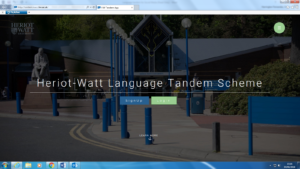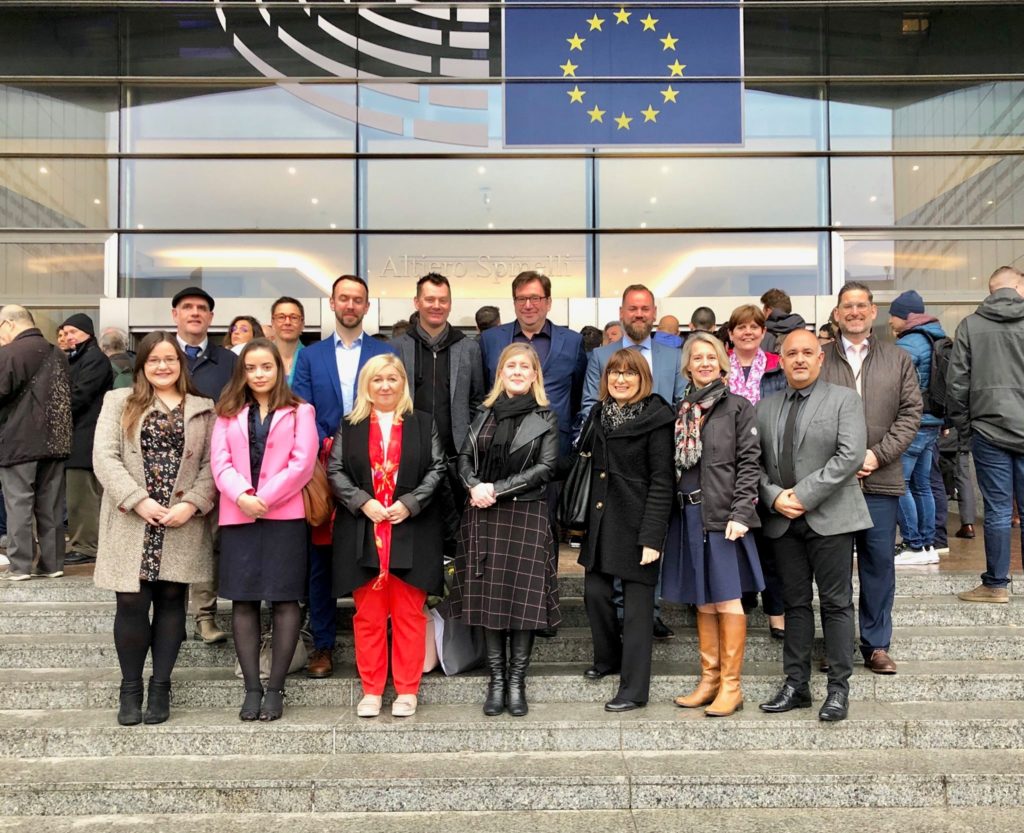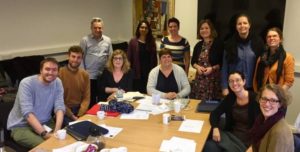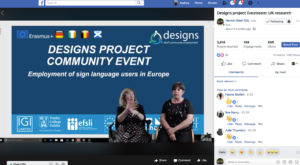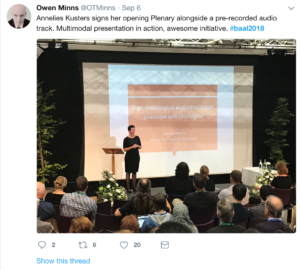Project progress update no. 2 – Jemina Napier
This v/blogpost is available in BSL, English, Spanish, French and Hindi
BSL: https://youtu.be/Q4bjGhdApfw
This v/blogpost is an update from the INforMHAA project team on our progress on the project to date.
The first v/blogpost gave an overview of the project and our goals, the planned key phases of the project, and the involvement of our Advisory Group and Patient & Public Engagement (PPIE) Group.
As a reminder, mental health assessments carried out under the Mental Health Act in England and Wales (1983) are intended to determine whether a person’s voluntary or involuntary psychiatric commitment is necessary for reasons of psychic disorder. When the person evaluated speaks a language other than the one used by health system professionals, it is necessary to use the linguistic mediation services of a professional interpreter.
The overall research question for the project is: How does interpreter mediation impact on Mental Health Act Assessments and how can interpreter-mediated Mental Health Act Assessments be improved?
With the following sub-questions:
- To what extent and how does the involvement of a spoken/signed language interpreter in Mental Health Act (MHA) assessments constrain or enable best Approved Mental Health Professional (AMHP) practice?
- When might it be more appropriate to use language concordant services (e.g. language/cultural advocates) rather than interpreters within AMHP practice and how?
- What constitutes an effective training model for AMHPs and professional interpreters?
What did we know at the start of the project?
- Evidence of disparities in disposal by ethnicity and cultural heritage did not encompass language use
- CQC and NHS Digital do not publish data on language use of those assessed nor whether interpreter was used
- No attention given to language mediated MHA assessments in MHA reform documentations
- Code of practice requires ‘interview in suitable manner’ with some mention of interpreters and cultural advocates
- England and Wales are highly linguistically diverse countries
- There is no previous comprehensive review of evidence about interpreter mediated MHA assessments or their international equivalents
- There is no published good practice guidance for AMHPs, interpreters or Section 12 doctors
- The impact on service users and carers of interpreter mediated MHA assessment is unknown
- Language of the assessment and whether an interpreter was used is not in the minimal data set for NHS digital annual reporting of MHA nor in CQC publications of standards
This second v/blogpost gives an update of what we have done so far in order to interrogate what more we need to know and how to ensure best practice in interpreter-mediated MHA assessments.
To date we have:
- Published the protocol for a Covidence-assisted scoping review of relevant empirical work and grey literature on interpreting in Mental Health Act assessments and identified 40 studies which will form the basis of the full review. None are of direct relevance to the questions of our study.
- Conducted surveys with 132 AMHPs and 48 Interpreters about their experiences of working in MHA assessments.
- Conducted follow-up interviews with 17 AMHPs and 6 interpreters (+ 4 pending) who responded to the survey and agreed to be interviewed to delve deeper into their experiences and source examples of critical points of decision-making and co-operative professional practice for AMHPs and interpreters.
What do we know now?
- No literature has specifically addressed interpreting and mental health assessment during the ‘in the moment’ of MHA assessments nor the requirements of AMHPs and interpreters to meet those situations
- Interpreter-mediated MHA assessments although infrequent are a constant. Of the 132 AMHPs in the survey most averaged 5 interpreter-mediated assessments a year
- AMHP report forms are not consistent in whether they ask questions about the language of the assessments and in what form them ask the question
- Asked about whether they recorded when they worked with an interpreter 100/115 AMHPs said ‘sometimes’ and just over 50% said they recorded the language combination of the interpreter
- If there seemed to be a ‘problem’ this was consistently noted by AMHPs
- Only 9/121 AMHPs could recall any training about working with interpreter as part of their qualifying course
- Since approval only 28% had participated in any training on working with interpreters
- Nearly 60% said their training had not adequately prepared them to work with interpreters whether as an AMHP or in any other role/setting.
- Due to the occasional difficulties of language output by person assessed, interpreters might need to implement special adjustments to their regular interpreting practice, for example, adopting a meta-descriptive approach to their interpreting renditions ‘when language does not make sense’ instead of ‘tidying up’ language. This requires a strong sense of trust in the interpreter on the part of the AMHP.
- Interpreters need support and supervision so that the sensitive nature of these encounters does not negatively impact in their personal wellbeing and resulting professional performance.
- Interpreters’ wider understanding of the legislative aspect of MHA assessments, not just linguistic aspects, is a clear success factor to ensure good quality communication between the parties. Concepts like ‘section 12’ ‘nearest relative’ ‘objection’ have a strong legal component that differs from general linguistic meaning, which highlights the importance of specialist training.
- Importance of considering ‘inter-professional dynamics’ in this context.
A few key issues highlighted by our research so far:
- AMHPs and interpreters have probably never met before when they first enter an MHA assessment
- AMHPs have little or usually no access to the language of the service user and assessment and this affects their ability to pick up holistically information about the mental state and level of understanding of the person being assessed
- AMHPs usually have no idea whether the interpreter has any background experience in MHA assessments and it is hard to specify this as a requirement when booking an interpreter
- Most interpreters have never taken part in an MHA assessment. Some have pre-existing concerns about the oppressive nature of social workers and of the MHA which can interfere with their role in the assessment
- Highly unlikely that interpreters and AMHPs have ever taken part in training in inter-professional working together or specifically in an MHA assessment
- AMHPs and interpreters are dependent on each other to ensure that best practice and conformation to legal practice are carried out
What else have we done?
- We have developed a bilingual project website in BSL and English, which gives a detailed overview of the project and all its aspects, including a team positionality statement.
- We have held quarterly meetings with our Advisory Group, who have engaged with the research design and data collection at all stages and have been critical in shaping the survey instruments, the simulation scenarios and recruiting participants. We are very sad to report that one of our advisory group members, Martin Stevens who was a senior research fellow for the NIHR policy research unit, passed away unexpectedly. We would like to extend our condolences to his family and colleagues, and acknowledge his valuable contribution to the INforMHAA project during his involvement.
- Our PPIE Group have begun their training, which is available through bilingual self-learning online modules in BSL and English. So far, they have completed three out of six planned sessions: Session 1 covered the INForMHAA team, understanding group work, diversity and inclusion; and Session 2 covered What is PPIE? – understanding PPIE, being familiar with how it works in research, being aware of NIHR PPIE standards and knowing how you can get involved in PPIE. And Session 3 covered ‘What is Research?’ – why we research, qualitative, quantitative and mixed-methods approaches and data collection methods. Session 4 will cover ‘Ethics and Consent’.
- We have completed filming of the simulated interpreter-mediated MHA assessment scenarios. We created four scenarios based on reporting from AMHPs and interpreters in the surveys and interviews of typical issues that they had come across in MHA assessments, and through consultation with the Advisory Group. The scenarios featured four different language combinations: Kurdish, Dutch, British Sign Language and Hindi. We completed filming in March 2022 with the support of the TIPP drama group from the University of Manchester.
- We have also given several presentations and produced some initial publications.
What is next?
- The simulation scenario videos are now being edited together for the next stage of the project. This will involve: (i) analysis of the critical points in the interactions using GoReact annotation software and (ii) simulation observations where we will ask interpreters and AMHPs to observe these simulations online using the multilingual interpreting function in Zoom webinar and the Mentimeter audience survey tool to discuss what they see as best practice, what they see are the issues and how things can be improved.
- We are working on publications from the survey and interview data, and also plan to write an article on the innovative methodologies we have used in this project.
- All of the data will feed into various planned outcomes, including the co-production of new training resources and professional best practice guidelines, information for AMHPs and interpreters, and a proposed new Theory of Change model for conducting interpreter-mediated MHA assessments.




